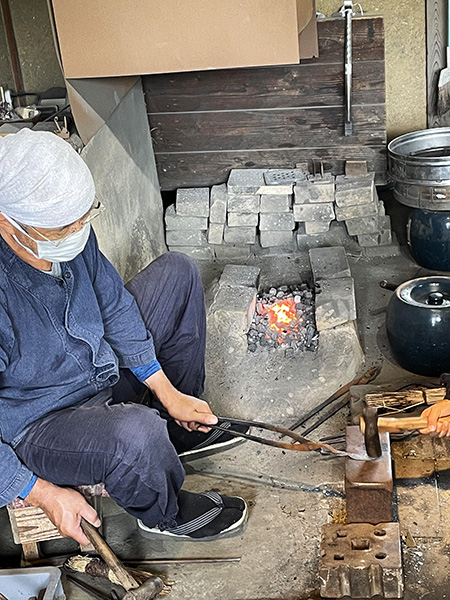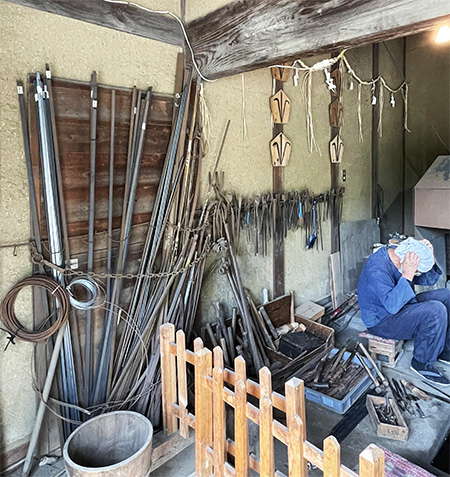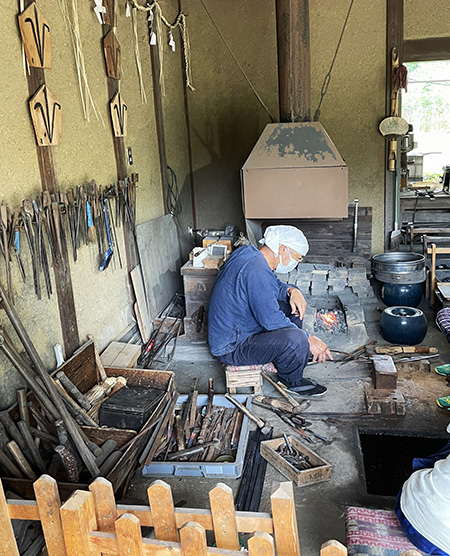


唱歌で「村の鍛冶屋」という歌が歌われていた。あれは江戸期を過ぎて明治になって国民皆教育制度が始まったときに音楽の題材として取り上げられたもの。このブログの前シリーズでも「鍛冶屋」は取り上げたが、この時代までは確実にこのように庶民の暮らしのなかに存在していたのだ。
歴史的には日本列島に水田農耕が導入された3000年前くらいから、鉄製農具は産業利器として欠かせない存在であり補修も含めて鍛冶屋はきわめて枢要な社会的存在だっただろう。音楽唱歌を定めたとき日本人として、この生業を外すことは常識では考えられなかったのだと思う。
唱歌での謳われ方も、非常に活動的で「活気」そのものの社会存在として活写されていた。「ふいごも休まず」という一生懸命さは日本社会のダイナミズムの象徴でもあったのだろうか。
農機具は毎日のように使用するものであり、相手にする田畑から石などが露出してきて刃先が欠けるなどは日常的に発生しただろう。高価だったことが自明なその農具は人びとの命とくらしにとってかけがえのない存在。村の鍛冶屋はその「命綱」として有用だった。子どもたちにとってもワクワクする作業ぶりだっただろうし、またそういう職人仕事の見事さにこころが奪われてもいただろう。おとなの人間の職業としてリスペクトを強く感じさせてくれる存在だった。

この房総のむらではひとつの「町家」として展示され、また写真のように実演もされているので子どもたちを中心にたくさんの見物を集めていた。鉄製品を加熱して加工しやすいようにして、叩いて成形していく。その変形していく様子は、役立つものが目に見えて生産されていくプロセスを目に焼き付けさせる。
職人さんの周りにはたくさんの「依頼品」が持ち込まれていて、「ああ、あれはこんなふうに傷んでいるんだ」「どうやって直していくのだろう」というように製造補修の「想像力」を大いに刺激してくれる。そしてそれが目の前で直されていく。自分の想像通りのプロセスであれば「そうかやっぱり」と納得できるし、意外な補修がされていくと「おお、こんな考え方、やり方の方が合理的なんだ」というように社会教育されていく。
こういう社会教育には教科書はたぶん意味がない(笑)。また教えられたことについてテストの点数評価もできにくいだろう。職人さんには独特のスタイルがあり、そのひとなりの合理性根拠があってやり方はたぶん千差万別。ただ目的に対して真摯に向き合っていく生き方とか姿勢とかが、見る者に伝わっていくものだろう。子どもたちはそういう大人の姿を見て、さまざまにこころでピンナップしていく。いわばこころを育てる教育なのだろうか。
English version⬇
The town’s blacksmith” and “fugo (blowtorch)” never rests.
The wisdom and ingenuity of adults who provided social educational opportunities for children from the Edo period to the early Showa period. It conveys the importance of being useful to others.
The song “The Village Blacksmith” was sung in Shoka. That was taken up as a subject for music when the universal education system started in the Meiji era after the Edo period. The “blacksmith” was also discussed in the previous series of this blog, and up until this time, it certainly existed in the daily lives of the common people in this way.
Historically, iron agricultural tools were indispensable as industrial tools from around 3,000 years ago when rice paddy farming was introduced to the Japanese archipelago, and the blacksmith, including repair work, was probably an extremely important social presence. When the Japanese people wrote the musical shoka, it would have been unthinkable to exclude this occupation from their lives.
The way it was described in the shoka was also very active, and depicted a social existence of “vitality” itself. The “Fugo mo mo yasumu” (Never rest, no matter how hard you work) may have been a symbol of the dynamism of Japanese society.
Farm machinery was used daily, and chipping of the cutting edges would have occurred on a daily basis due to exposure to stones and other debris from the fields they were working in. It is obvious that these expensive farming implements were irreplaceable for people’s lives and livelihoods. The village blacksmith was useful as a “lifeline. The work must have been exciting for the children, and they must have been fascinated by the beauty of such craftsmanship. It was an existence that made me feel a strong respect for it as a profession for adults.
At this Boso no Mura, it was displayed as a single “machiya” (townhouse) and was also demonstrated as shown in the photo, attracting many spectators, especially children. Iron products are heated to make them easier to process, and then beaten and shaped. The deformation of the products makes the process of producing useful things visible to the eye.
Many “commissioned products” were brought in around the craftsmen, which greatly stimulated the “imagination” of manufacturing repair, such as “Oh, that is damaged like this,” and “I wonder how they will fix it. And then, it is repaired right in front of my eyes. If the process is as I imagined, I am convinced, and if the repair is done in an unexpected way, I am socially educated to think, “Wow, this way of thinking and doing things is more rational.
Textbooks are probably meaningless for this kind of social education (laughs). It would also be difficult to evaluate test scores on what was taught. Craftspeople have their own unique styles and rationale, and their methods probably vary widely. However, the way of life and attitude of sincerely facing one’s objectives will be conveyed to those who see them. Children will see such an adult figure and pin up their hearts in various ways. In other words, it is an education that nurtures the heart.
Posted on 1月 10th, 2023 by 三木 奎吾
Filed under: 日本社会・文化研究, 歴史探訪







コメントを投稿
「※誹謗中傷や、悪意のある書き込み、営利目的などのコメントを防ぐために、投稿された全てのコメントは一時的に保留されますのでご了承ください。」
You must be logged in to post a comment.